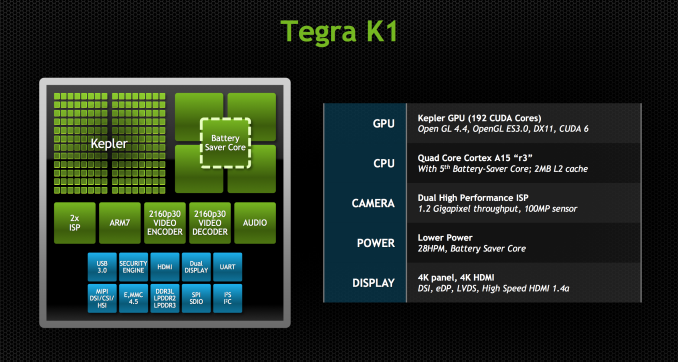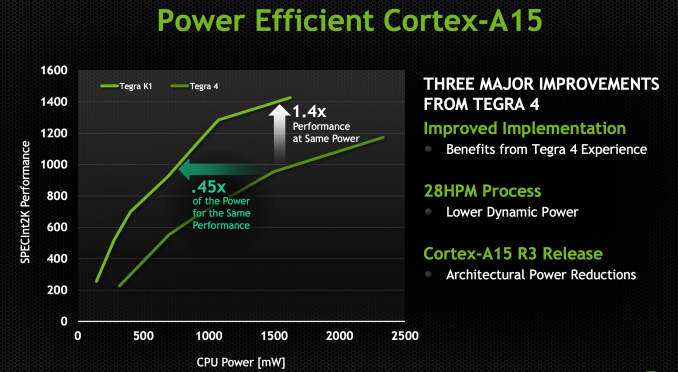NVIDIA Tegra K1 Preview & Architecture Analysis
by Brian Klug & Anand Lal Shimpi on January 6, 2014 6:31 AM EST
NVIDIA has taken to using CES as its platform for launching members of its Tegra mobile SoC family. This year was no different as it shifted branding a bit in its announcement of the Tegra K1, formerly known as Project Logan.
With Tegra 2 NVIDIA’s big selling point was being first to dual-core in Android. Tegra 3 attempted to do the same with being first to quad-core. Tegra 4 just made things faster. Tegra K1 on the other hand does away with the gimmicks and instead focuses on fundamentals.
The SoC will come in two versions, one version with a quad-core (4+1) Cortex-A15, and one that leverages two of NVIDIA’s own 64-bit ARMv8 Denver CPUs. More importantly, they both ship with a full implementation of NVIDIA’s Kepler GPU architecture. In fact, Tegra K1 marks a substantial change in the way NVIDIA approaches mobile GPU design. From this point forward, all mobile GPUs will leverage the same architectures as NVIDIA’s desktop parts. As if that wasn’t enough, starting now, all future NVIDIA GeForce designs will begin first and foremost as mobile designs. NVIDIA just went from playing with mobile to dead serious in a heartbeat.
Tegra K1 will also be NVIDIA's launch vehicle for Project Denver, it's first fully custom ARMv8 CPU core. More on that in a bit.
CPU Option 1: Quad-Core ARM Cortex A15
Tegra K1 will ship in two configurations. The first went into production at the end of December 2013, is shipping to OEMs this quarter and will be in devices, allegedly, in the first half of 2014. This first configuration is based on ARM’s Cortex A15 CPU core.
Much like Tegra 4, the A15 version of Tegra K1 features four Cortex A15s synthesized for high frequencies and a fifth Cortex A15 that’s optimized for low power/frequency operation. The fifth core, what NVIDIA likes to call a shadow or companion core, is swapped in during periods of very low CPU usage (e.g. idle, screen off in your pocket updating new tweets/emails). As CPU demands grow the companion core is switched out for one of the four high performance cores, then two, then three and finally all four can be plugged in at once (but never five).
Tegra K1 ships with a newer revision of the Cortex A15 (r3p3) than what was in Tegra 4 (r2p1). ARM continuously updates its processor IP, with each revision bringing bug fixes and sometimes performance improvements. In the case of Tegra K1’s A15s, the main improvements here have to do with increasing power efficiency. With r3p0 (which r3p3 inherits) ARM added more fine grained clock gating, which should directly impact power efficiency.
The combination of the newer Cortex A15 revision and the move to 28nm HPM give Tegra K1 better performance at the same power consumption or lower power consumption at the same performance level. The reality tends to be that mobile OEMs will pursue max performance and not optimize for a good performance/power balance, but it’s at least possible to do better with Tegra K1 than with Tegra 4.
The max CPU clock goes up from 1.9GHz to 2.3GHz, a direct result of the move to 28nm HPM; 2.3GHz is the max CPU clock regardless of the number of active cores. The max performance increase over Tegra 4 running at max clocks will be just over 20%.
NVIDIA hasn’t made any changes to the L1/L2 cache configuration with Tegra K1. We’re still dealing with a shared 2MB L2 and 32KB/32KB L1s (I$+D$) per core.
The companion core can scale up to 1GHz, but tends to run at around 500MHz.
Feeding the CPU (and GPU) cores is a 64-bit wide LPDDR3 memory interface. NVIDIA will offer Tegra K1 in PoP, discrete and another package revision for standard clamshell notebook use.












88 Comments
View All Comments
blanarahul - Monday, January 6, 2014 - link
Quick question: Is it possible to build a 32-bit ARMv8 CPU core i.e. a ARMv8 core capable of running a 32-bit OS without using a hypervisor? That would really ease the transition to 64-bit for Android.blanarahul - Monday, January 6, 2014 - link
Anand, where do you find information about the revisions of Cortex cores??blanarahul - Monday, January 6, 2014 - link
Found it: http://infocenter.arm.com/help/index.jsp?topic=/co...klmx - Monday, January 6, 2014 - link
The real-time version of ARMv8 (ARMv8-R) is still 32-bit, and is capable of running a rich OS like Android, but I guess that's not the solution you had in minddroopaloop - Monday, January 6, 2014 - link
ARMv8 supports 2 different instruction sets; AArch32, and AArch64. AArch32 is basically the ARMv7 instruction set (read: 32bit). It is possible to run Android in AArch32. It is also possible to run the kernel in AArch64, and have AArch32 apps running on top which should help ease the transition to 64bit.Krysto - Monday, January 6, 2014 - link
How would using a 32-bit-only CPU ease the transition to 64-bit? ARMv8 supports both 32-bit and 64-bit modes by default (you can make it 64-bit-only later, though), so that's what needed for the "transition to be easier" - OEMs to just jump to ARMv8, even if the OS remains 32-bit.phoenix_rizzen - Monday, January 6, 2014 - link
This is exactly what Apple did with their A7 SoC. It's an ARMv8 CPU. It can run either a 64-bit or 32-bit version of iOS. If running the 64-bit version, it can run either 32-bit or 64-bit apps.Krysto - Monday, January 6, 2014 - link
That's what everyone will do. That's what I'm saying. It's the default. OEMs just need to switch to ARMv8, and that's it. It's up to Google to make Android 64-bit, and then to app devs to make their apps 64-bit, but neither is "necessary" for the transition to 64-bit CPUs.BMNify - Tuesday, January 7, 2014 - link
remember The Cortex-A15 and above also introduced full hardware accelerated virtualization so you could also run several versions of an OS concurrently too if you so wished and skillful enough to code your apps base libraries with good generic and fast inter process communications (xcore style)deltatux - Thursday, January 9, 2014 - link
Why would you need to build a 32-bit ARMv8 core? Android is highly portable, just recompile the entire thing to the aarch64 instruction set and you're good to go. Nearly all apps are written in Dalvik anyways which means you won't have to recompile those apps and ARMv8 in itself is backwards compatible with 32-bit just like how x86-64 is backwards compatible with the original 32-bit x86. So even if there are 32-bit native apps, they can easily run on 64-bit Android.NVIDIA has shown off Android 4.4 running on Denver in 64-bit mode, so 64-bit Android does exist and works out of the gate.